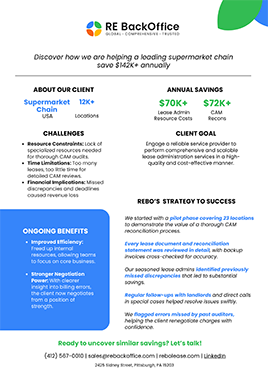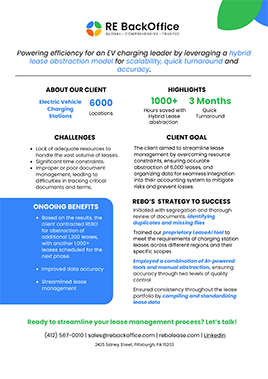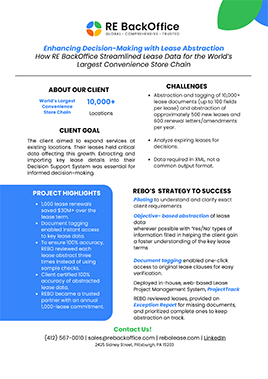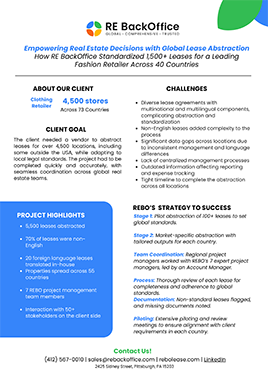
Understanding CAM Reconciliation
CAM reconciliation, an essential aspect of commercial lease agreements, ensures equitable distribution of expenses among tenants for shared spaces and services. This process involves comparing estimated payments made by tenants throughout the year with the actual expenses incurred by the landlord. Led by Lease Administrators and landlords, CAM reconciliation requires meticulous attention to detail and adherence to lease terms to maintain transparency and fairness in expense allocation.
Here's a detailed checklist outlining essential items to consider during CAM reconciliation
CAM Exclusions
At the heart of CAM reconciliation lies the identification of CAM exclusions. These are expenses that should not be included in common area maintenance charges. Examples of non-reimbursable expenses include capital expenditures, roof repairs, depreciation, tenant improvement allowance, amortization, and administrative and management fees. It is crucial to differentiate between expenses directly related to operating the building, which should be charged to tenants, and those that fall under exclusions.
Administrative and Management Fees
Another critical aspect of CAM reconciliation is ensuring that administrative and management fees charged to tenants are within the predetermined limits specified in the lease agreement. These fees, typically ranging from 5% to 10% of costs, cover expenses associated with property management. Lease Administrators must review invoices and contracts to verify the accuracy of these fees, particularly when third-party management companies are involved.
CAM Pay Method
In commercial real estate leases, Common Area Maintenance (CAM) payment methods and frequency are crucial factors that determine how tenants contribute to shared space expenses. Here's a concise overview:
CAM Payment Methods -
- Actual Payment: Tenants pay for common area expenses as they occur, based on actual costs incurred by the landlord.
- Estimated Payment: Tenants pay monthly estimates, typically based on the previous year's expenses. At year-end, actual expenses are reconciled, and adjustments are made.
CAM Payment Frequency
In addition to the payment method, CAM payment frequency also varies depending on the lease agreement. Payments can occur monthly, quarterly, annually, or semi-annually. While approximately 10% of larger tenants may opt for an annual payment covering the actual amount, most lease agreements specify quarterly or semi-annual payment frequencies. The chosen frequency can impact cash flow management for both landlords and tenants, with some preferring the predictability of monthly payments while others may opt for less frequent payments to reduce administrative burden.
CAM Caps
Lease agreements often include provisions for CAM caps, which set a limit on annual increases in controllable operating expenses. Tenants agree to these caps to control their financial obligations and prevent unforeseen spikes in expenses. It is essential to calculate the cap percentage accurately and ensure that any expenses exceeding the cap are the responsibility of the landlord, not the tenants.
CAM Base Year
The CAM base year is the starting point for comparing how much tenants need to pay for common area maintenance in later years of their lease. Usually, if it's not mentioned in the lease, it's just the first year of the lease. This helps both landlords and tenants keep track of any changes in maintenance costs over time. It's basically a reference point for understanding how much maintenance costs might go up or down during the lease.
CAM Management Fee
In addition to administrative and management fees, CAM reconciliation may involve CAM management fees. These fees compensate management companies responsible for maintaining common areas, especially in large shopping centers with numerous tenants. Landlords may pass a portion of these fees on to tenants, within specified limitations outlined in the lease agreement.
Annual Reconciliation
At the end of each year, CAM reconciliation takes place to compare estimated payments with actual expenses incurred. Landlords issue reconciliation statements to tenants, adjusting any excess or deficit in payments. These statements provide transparency and accountability, facilitating fair resolution of financial discrepancies.
Forfeiture Rights
Forfeiture rights allow tenants to waive payment obligations if the landlord fails to provide timely notification of bills. Lease agreements often stipulate that tenants should directly pay bills, with penalties for late payment. However, if tenants do not receive bills on time, they have the right to forfeit payment, placing the responsibility on the landlord to settle the bill promptly.
CAM Penalty
CAM penalties, such as late payment fees or interest, may be imposed if tenants fail to pay CAM charges by the due date. Similar to base rent, CAM charges are a monthly payment, and failure to pay on time can result in financial penalties. Lease Administrators must ensure that penalties are applied fairly and in accordance with lease agreements to maintain tenant satisfaction and compliance.
Operating Expenses Gross-Up
Operating expenses gross-up provisions address situations where a building is not fully occupied. In such cases, landlords have the right to increase operating expenses for calculating tenants' proportional share, assuming full or 95% occupancy. This ensures that essential services like cleaning and elevator functionality are maintained throughout the entire building, benefiting both occupied and unoccupied tenants.
Taxes
Property taxes, a significant component of CAM expenses, are government-imposed levies applicable to all properties. Typically, landlords handle property taxes for the entire building but collect tenants' proportional shares, as outlined in lease agreements. Additionally, tenants may be responsible for personal property taxes related to improvements within their premises.
Rent Tax
In some jurisdictions, commercial tenants may be subject to rent tax, which is a tax imposed on the rental payments they make to landlords. Lease Administrators must be aware of any rent tax obligations applicable to tenants in their respective locations and ensure compliance with tax regulations.
Utilities
Utilities, including electricity, water, HVAC services, and sewer maintenance, are essential components of CAM expenses. These expenses may be directly paid by tenants or covered by landlords, with tenants reimbursing their portion based on pro-rata shares outlined in lease agreements. Sub-metering may be used to allocate utilities based on actual consumption, ensuring fairness in expense allocation.
In conclusion, CAM reconciliation is a complex yet vital process in commercial lease agreements, requiring collaboration between landlords, Lease Administrators, and tenants to ensure transparency and fairness in expense allocation. By adhering to the checklist outlined in this guide, Lease Administrators can facilitate smooth CAM reconciliation processes, mitigating disputes and fostering positive landlord-tenant relationships.


